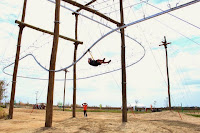Vigan, Ilocos Sur
Vigan city fourth class and capital city of the province of Ilocos Sur Philippines. It is located on the western coast of the large island of Luzon.
It is also a World Heritage Site that one of the few Hispanic towns left in the Philippines where the structures remained intact and well known for its cobblestone streets and unique architecture fuses Philippine and oriental building designs and constructions.
Historic town of Vigan:
Calle Crisologo(Crisologo
Street)
The cobbe-stoned
street in Vigan with Spanish period ancestral houses left and right different faces
of houses depending on the time of the day.
The major attraction
is mestizo district which is filled with Spanish- style houses that evoke a
bygone era.
Experienced to transported
back to this period in Philippine Spamish colonial time through walking or ride
in calesa ride through Vigan’s Calle Crisologo or Mena Crisologo street is a
must.
Syquia Mansion
Elpidio Quirino the 6th
President of the Philippines, is just one of the illustrious characters who
hail from Vigan. He onced live in Syquia mansion on Calle Quirino, the
ancestral home of his wife’s family. The mansion not juzst has a historical
significance but its beauty of wood carving of pageboys, country lasses and
other beautiful decoration.
heritage river cruise in Mestizo River

source;http://www.rappler.com/
Vigan's rich history began way before Spanish conquistador Juan de Salcedo named it Spanish territory. The winding Mestizo River traces this history back to pre-colonial times when Vigan natives traded with the Chinese who moored their boats on the riverbanks.
Cruise-goers literally travel through history by travelling through the river. The boat takes them to various points where life-sized dioramas stand, depicting important events in Vigan's history. A recorded voice then narrates the story.
The riverbanks are also the perfect exhibit of Vigan's rich biodiversity. You'll catch a glimpse of the bigaa plant from which the city supposedly takes its name.
Father Burgos' house
A bahay na bato near the Ilocos Sur Provincial Hall once housed one of the greatest names in Philippine nationalism: Padre Jose Burgos of the Gomburza trio. Along with fellow priests Mariano Gomez and Jacinto Zamora, Burgos was sentenced to death for a false charge of rebellion against Spanish colonizers.
Their death would later on inspire national hero Jose Rizal who dedicated his novel "El Filibusterismo" to their memory.
Today, Padre Burgos' childhood home is a museum for all things Vigan. Here you'll find old farming and weaving implements, photos of prominent Bigueños and more.
Stand in Padre Burgos' bedroom and imagine him writing letters on his desk, complete with antique writing implements.
Climb up Bantay Bell Tower
Bantay Bell Tower is a glorious brick edifice that stands lonely on a green hill overlooking Bantay, a municipality northeast of Vigan.
Enterprising local guides help visitors get the most of the picture-perfect scenery by choreographing poses in which the visitors appear to be leaning on the tower, carrying it with their bare hands or even forming a heart shape using their arms.
You can then climb the winding staircase up to the top of the tower where the enormous main bell which dates back to World War II (it has bullet marks to prove it) hangs. Smaller bells surround it in a protective ring.
The bell tower stands beside the St Augustine Parish, also known as the Sanctuary of the Nuestra Señora de La Caridad. It is one of the oldest churches in Ilocos Sur and, according to our guide Bro Francis, was where Diego Silang imprisoned priests during his 1763 revolt against the Spaniards.
The imposing church was once in the shape of a cross if viewed from above. Ruins are all that remain of the two wings of the church that formed the arms of the cross. In an eerily beautiful tribute, mass is still held in one of the ruins.



















